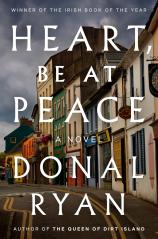Heart, Be at Peace
Review
Heart, Be at Peace
Life in Ireland’s small towns has provided a seemingly inexhaustible source of material to the writers of a country whose contribution to world literature dwarfs its population. It’s not necessary to reach back into literary history to find them when there are so many fine recent examples, like Niall Williams’ TIME OF THE CHILD, Colin Barrett’s WILD HOUSES, and Caoillin Hughes’ THE ALTERNATIVES.
It’s no surprise, then, that Donal Ryan --- twice-nominated for the Booker Prize --- has dipped into that deep well to find the inspiration for his latest novel, HEART, BE AT PEACE. Marrying an unusual structure to a lucid prose style, it’s a moving reflection on the complexities of life in a town that a casual observer might be inclined to dismiss at first glance as a place where nothing happens.
The book is set in the approximate present in the town of Nenagh, County Tipperary (where Ryan lives), which is about a 30-minute drive from the city of Limerick. His ambitious stylistic choice is to assign the telling of the story to 21 inhabitants of the town, each of whom he grants one chapter. Gradually, over the highly compressed narrative of just under 200 pages, their stories overlap and echo to reveal the sorrows and joys of Nenagh’s daily life.
"Marrying an unusual structure to a lucid prose style, [HEART, BE AT PEACE is] a moving reflection on the complexities of life in a town that a casual observer might be inclined to dismiss at first glance as a place where nothing happens."
Out of this chorus, a few key voices emerge. Most notable among them are Bobby Mahon, the owner of a successful home renovation company, whose prosperity conceals an explosive temper, and Seanie Shanahan, his employee and friend, who displays a seemingly ineradicable propensity for infidelity. Seanie’s craftily staged compromising photograph of Bobby, taken at a stag party in Amsterdam, threatens to upend Bobby’s family life and his standing in the community.
For all the apparent normalcy of their lives, the town where they live seems far from a safe and quiet place. Bobby lost his father to a murder more than a decade earlier, and Seanie’s now-13-year-old son, Dylan, briefly was kidnapped from his day care when he was two. Josie Burke’s son is involved in a fraudulent school for immigrants that serves as a cover for drug smuggling. But the most dangerous thread that runs through the town’s fabric involves the activities of Augie Penrose’s small but ruthless drug gang.
Augie and his thugs show no compunction about stealing from the cash hoard of a girlfriend’s grandmother or demanding payment of drug debts from the survivors of customers who die from overdoses, as they recruit living addict debtors into their criminal activities. As Bobby watches these events with seething anger over this threat to thwart the town’s peace and order, he is often “lost in close and quiet consideration of terminal violence,” as he draws ever closer to taking action to remove this scourge permanently. Jim Gildea, a retired police officer, knows the “futility of vigilantism” and observes Bobby’s rising fury with fear for the moment when it will explode.
But for all the incipient violence that shadows the story, Ryan is careful to sow seeds of redemption and hope. There’s Lloyd, one of the hapless convicted kidnappers who begins writing dramatic monologues while serving his prison sentence and eventually secures an Arts Council grant to subsidize his art. And there’s the improbable relationship that forms between Bobby and Denis, the man who killed Bobby’s father, after Bobby visits him during his incarceration. While parts of Nenagh’s body may be infected with evil, Ryan suggests, the illness is not terminal.
Ryan rounds out the novel with a fitting climax, but how that is achieved seems less interesting than how he makes it easy to identify with the daily trials and small triumphs of these characters. “We all spend half our lives in denial,” muses Seanie’s wife, Réaltín. In that state, and in the many other ways we can glimpse here, Donal Ryan invites us to ask how different they are from us.
Reviewed by Harvey Freedenberg on May 24, 2025
Heart, Be at Peace
- Publication Date: May 20, 2025
- Genres: Fiction
- Hardcover: 208 pages
- Publisher: Viking
- ISBN-10: 059383464X
- ISBN-13: 9780593834640




